International Financial Reporting Report - Finance Module, Semester 1
VerifiedAdded on 2022/12/28
|16
|3852
|28
Report
AI Summary
This report provides a comprehensive overview of international financial reporting. It begins with an introduction to international finance and its relevance to companies managing finances globally. Part A delves into the IASB's Conceptual Framework, explaining its purposes, underlying assumptions, and the concepts of capital maintenance. It also examines qualitative characteristics of financial statements and the concept of materiality. Question 2 addresses the first-time adoption of International Financial Reporting Standards (IFRS), including definitions of key terms and requirements of IFRS 1. Part B focuses on specific accounting topics, including lease accounting under IFRS 16, calculation of implicit interest rates, and accounting entries for residual values. It also includes the preparation of a cash flow statement in accordance with IAS 7. The report concludes with a discussion of the key concepts and principles of international financial reporting.
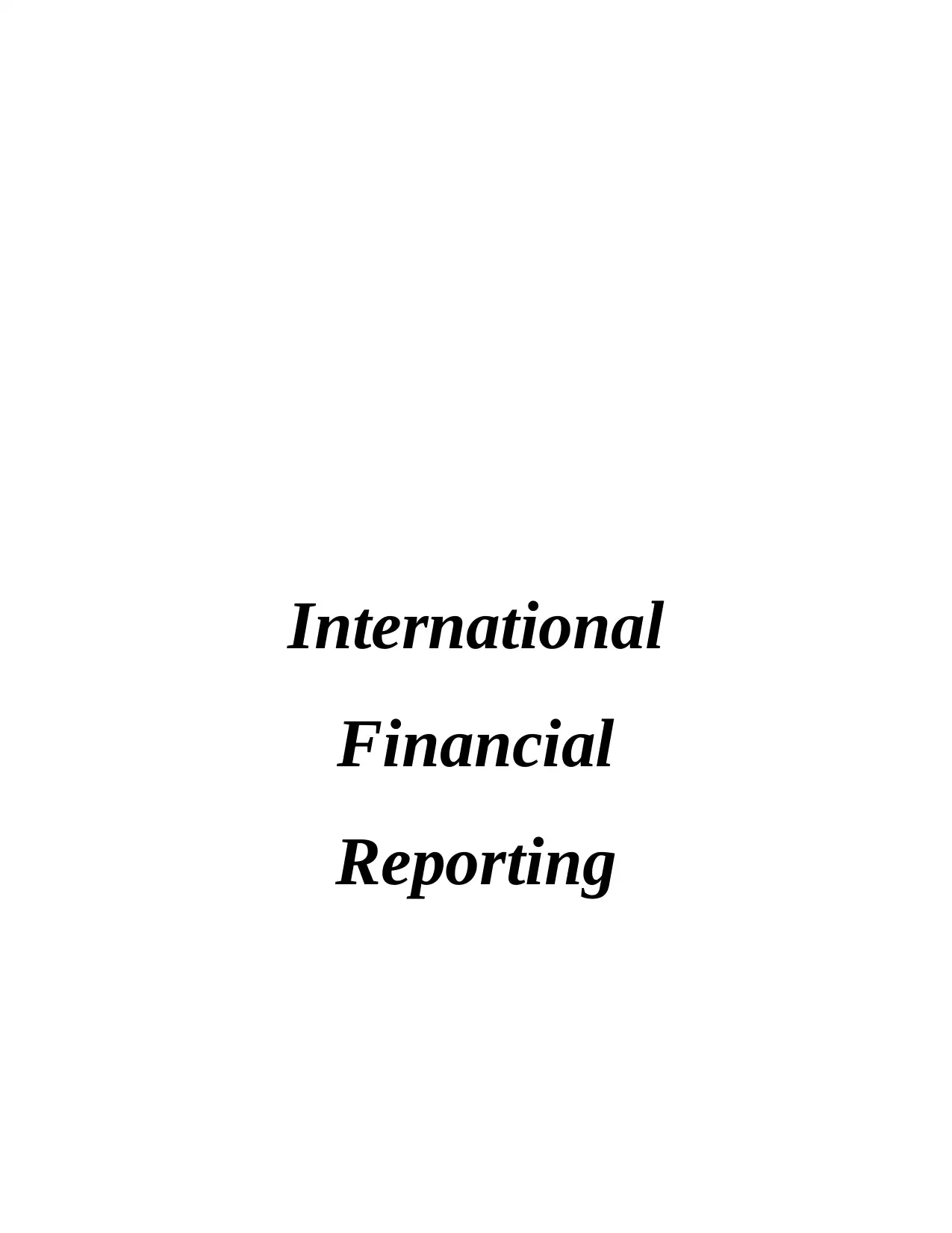
International
Financial
Reporting
Financial
Reporting
Paraphrase This Document
Need a fresh take? Get an instant paraphrase of this document with our AI Paraphraser
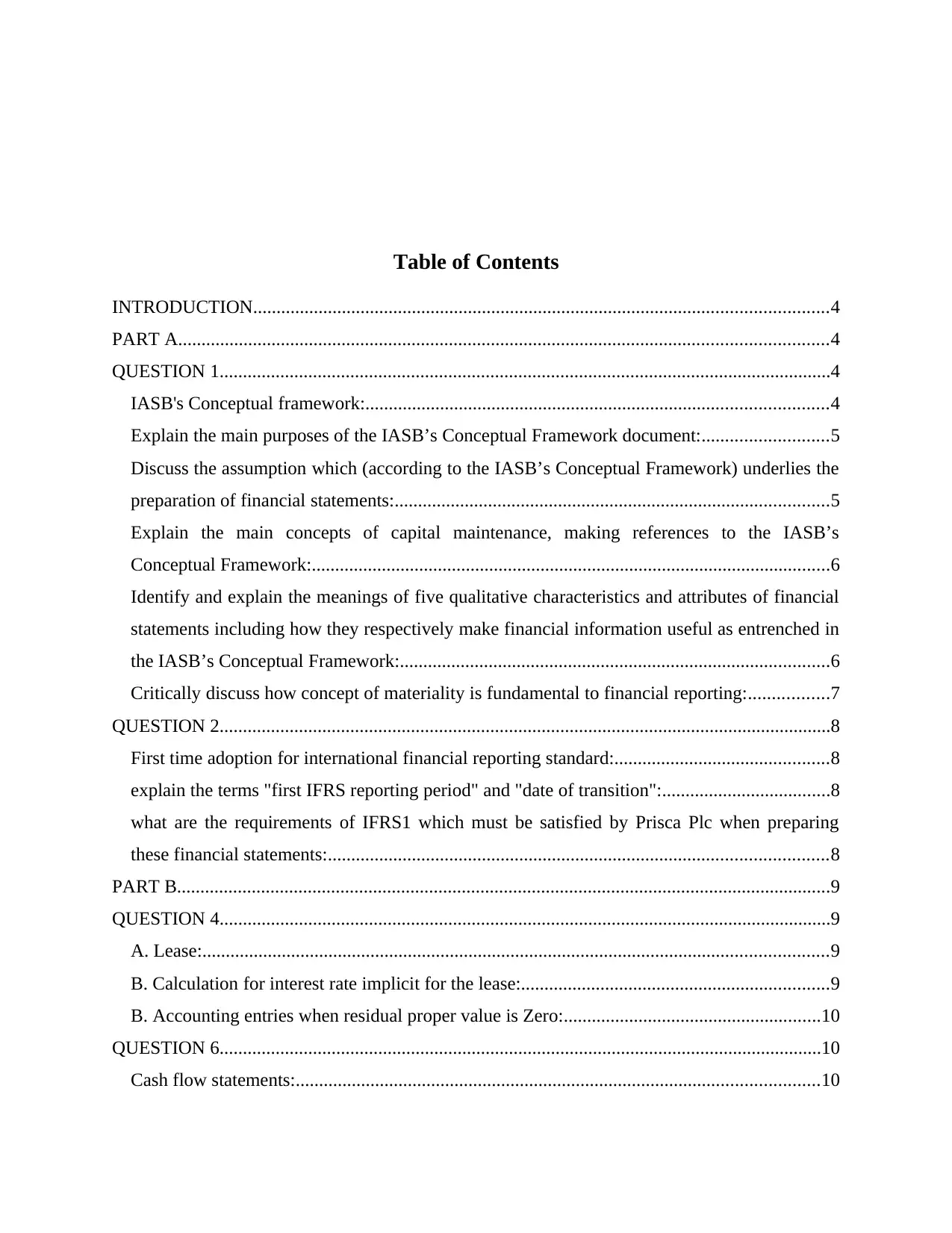
Table of Contents
INTRODUCTION...........................................................................................................................4
PART A...........................................................................................................................................4
QUESTION 1...................................................................................................................................4
IASB's Conceptual framework:...................................................................................................4
Explain the main purposes of the IASB’s Conceptual Framework document:...........................5
Discuss the assumption which (according to the IASB’s Conceptual Framework) underlies the
preparation of financial statements:.............................................................................................5
Explain the main concepts of capital maintenance, making references to the IASB’s
Conceptual Framework:...............................................................................................................6
Identify and explain the meanings of five qualitative characteristics and attributes of financial
statements including how they respectively make financial information useful as entrenched in
the IASB’s Conceptual Framework:............................................................................................6
Critically discuss how concept of materiality is fundamental to financial reporting:.................7
QUESTION 2...................................................................................................................................8
First time adoption for international financial reporting standard:..............................................8
explain the terms "first IFRS reporting period" and "date of transition":....................................8
what are the requirements of IFRS1 which must be satisfied by Prisca Plc when preparing
these financial statements:...........................................................................................................8
PART B............................................................................................................................................9
QUESTION 4...................................................................................................................................9
A. Lease:......................................................................................................................................9
B. Calculation for interest rate implicit for the lease:..................................................................9
B. Accounting entries when residual proper value is Zero:.......................................................10
QUESTION 6.................................................................................................................................10
Cash flow statements:................................................................................................................10
INTRODUCTION...........................................................................................................................4
PART A...........................................................................................................................................4
QUESTION 1...................................................................................................................................4
IASB's Conceptual framework:...................................................................................................4
Explain the main purposes of the IASB’s Conceptual Framework document:...........................5
Discuss the assumption which (according to the IASB’s Conceptual Framework) underlies the
preparation of financial statements:.............................................................................................5
Explain the main concepts of capital maintenance, making references to the IASB’s
Conceptual Framework:...............................................................................................................6
Identify and explain the meanings of five qualitative characteristics and attributes of financial
statements including how they respectively make financial information useful as entrenched in
the IASB’s Conceptual Framework:............................................................................................6
Critically discuss how concept of materiality is fundamental to financial reporting:.................7
QUESTION 2...................................................................................................................................8
First time adoption for international financial reporting standard:..............................................8
explain the terms "first IFRS reporting period" and "date of transition":....................................8
what are the requirements of IFRS1 which must be satisfied by Prisca Plc when preparing
these financial statements:...........................................................................................................8
PART B............................................................................................................................................9
QUESTION 4...................................................................................................................................9
A. Lease:......................................................................................................................................9
B. Calculation for interest rate implicit for the lease:..................................................................9
B. Accounting entries when residual proper value is Zero:.......................................................10
QUESTION 6.................................................................................................................................10
Cash flow statements:................................................................................................................10
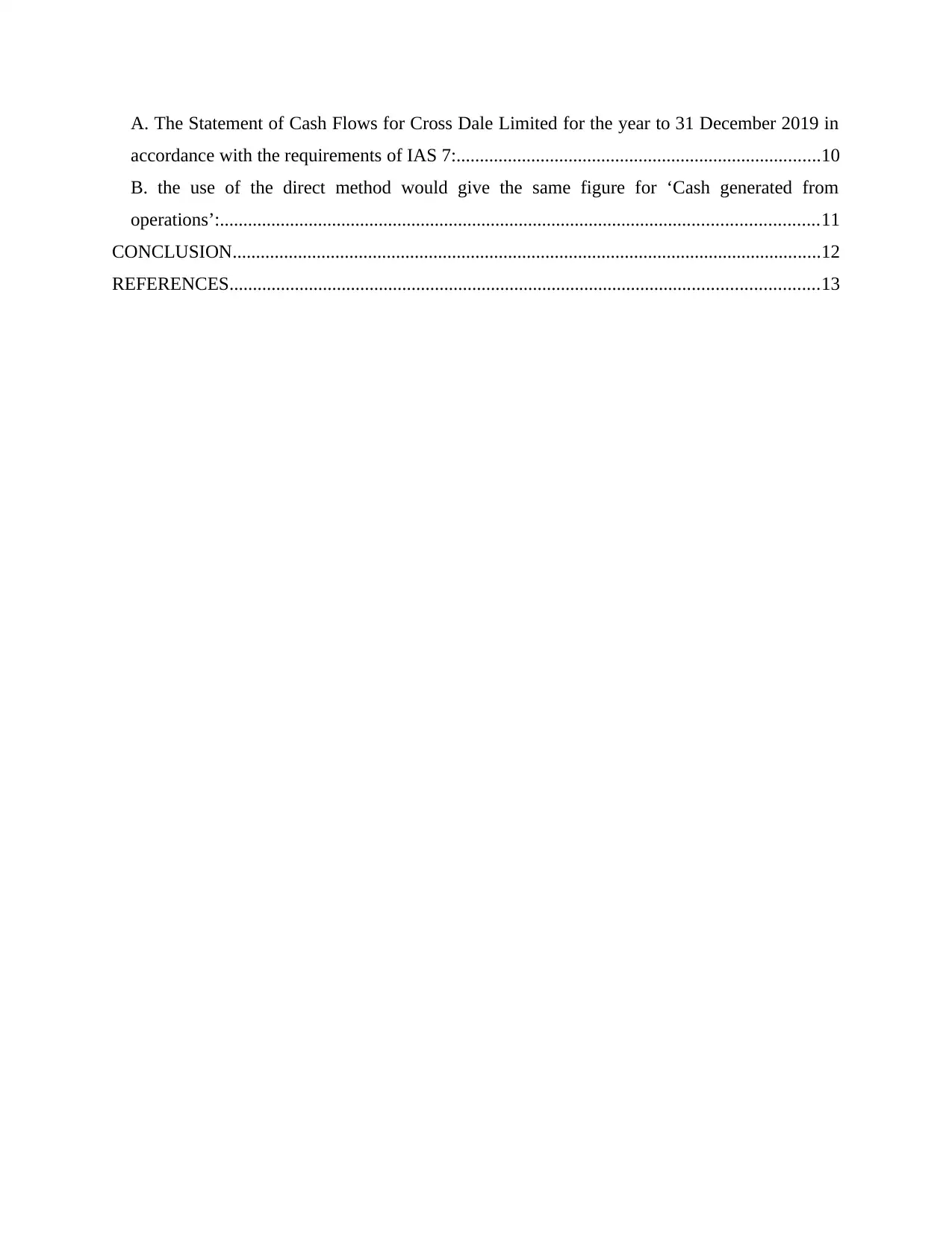
A. The Statement of Cash Flows for Cross Dale Limited for the year to 31 December 2019 in
accordance with the requirements of IAS 7:..............................................................................10
B. the use of the direct method would give the same figure for ‘Cash generated from
operations’:................................................................................................................................11
CONCLUSION..............................................................................................................................12
REFERENCES..............................................................................................................................13
accordance with the requirements of IAS 7:..............................................................................10
B. the use of the direct method would give the same figure for ‘Cash generated from
operations’:................................................................................................................................11
CONCLUSION..............................................................................................................................12
REFERENCES..............................................................................................................................13
⊘ This is a preview!⊘
Do you want full access?
Subscribe today to unlock all pages.

Trusted by 1+ million students worldwide

Paraphrase This Document
Need a fresh take? Get an instant paraphrase of this document with our AI Paraphraser
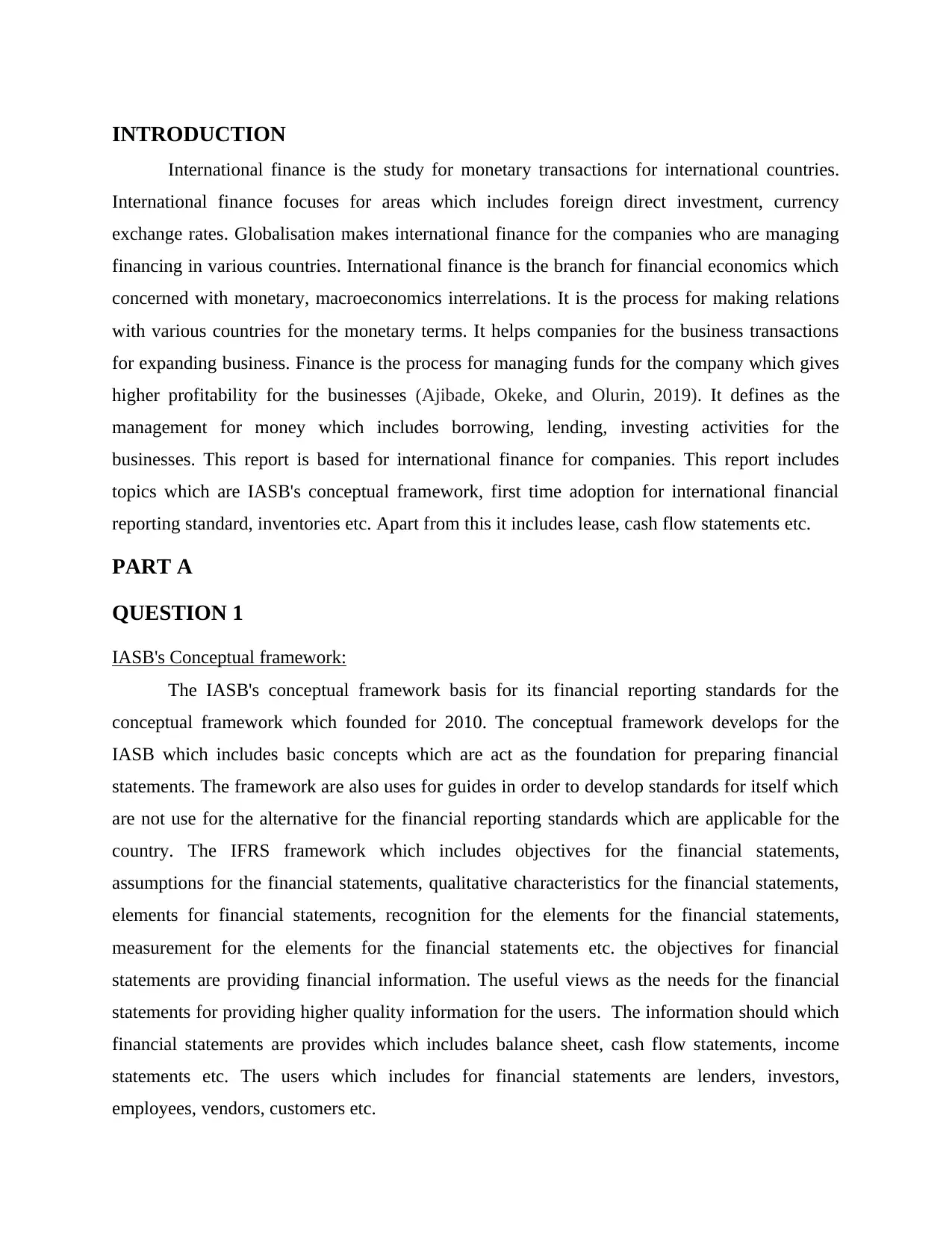
INTRODUCTION
International finance is the study for monetary transactions for international countries.
International finance focuses for areas which includes foreign direct investment, currency
exchange rates. Globalisation makes international finance for the companies who are managing
financing in various countries. International finance is the branch for financial economics which
concerned with monetary, macroeconomics interrelations. It is the process for making relations
with various countries for the monetary terms. It helps companies for the business transactions
for expanding business. Finance is the process for managing funds for the company which gives
higher profitability for the businesses (Ajibade, Okeke, and Olurin, 2019). It defines as the
management for money which includes borrowing, lending, investing activities for the
businesses. This report is based for international finance for companies. This report includes
topics which are IASB's conceptual framework, first time adoption for international financial
reporting standard, inventories etc. Apart from this it includes lease, cash flow statements etc.
PART A
QUESTION 1
IASB's Conceptual framework:
The IASB's conceptual framework basis for its financial reporting standards for the
conceptual framework which founded for 2010. The conceptual framework develops for the
IASB which includes basic concepts which are act as the foundation for preparing financial
statements. The framework are also uses for guides in order to develop standards for itself which
are not use for the alternative for the financial reporting standards which are applicable for the
country. The IFRS framework which includes objectives for the financial statements,
assumptions for the financial statements, qualitative characteristics for the financial statements,
elements for financial statements, recognition for the elements for the financial statements,
measurement for the elements for the financial statements etc. the objectives for financial
statements are providing financial information. The useful views as the needs for the financial
statements for providing higher quality information for the users. The information should which
financial statements are provides which includes balance sheet, cash flow statements, income
statements etc. The users which includes for financial statements are lenders, investors,
employees, vendors, customers etc.
International finance is the study for monetary transactions for international countries.
International finance focuses for areas which includes foreign direct investment, currency
exchange rates. Globalisation makes international finance for the companies who are managing
financing in various countries. International finance is the branch for financial economics which
concerned with monetary, macroeconomics interrelations. It is the process for making relations
with various countries for the monetary terms. It helps companies for the business transactions
for expanding business. Finance is the process for managing funds for the company which gives
higher profitability for the businesses (Ajibade, Okeke, and Olurin, 2019). It defines as the
management for money which includes borrowing, lending, investing activities for the
businesses. This report is based for international finance for companies. This report includes
topics which are IASB's conceptual framework, first time adoption for international financial
reporting standard, inventories etc. Apart from this it includes lease, cash flow statements etc.
PART A
QUESTION 1
IASB's Conceptual framework:
The IASB's conceptual framework basis for its financial reporting standards for the
conceptual framework which founded for 2010. The conceptual framework develops for the
IASB which includes basic concepts which are act as the foundation for preparing financial
statements. The framework are also uses for guides in order to develop standards for itself which
are not use for the alternative for the financial reporting standards which are applicable for the
country. The IFRS framework which includes objectives for the financial statements,
assumptions for the financial statements, qualitative characteristics for the financial statements,
elements for financial statements, recognition for the elements for the financial statements,
measurement for the elements for the financial statements etc. the objectives for financial
statements are providing financial information. The useful views as the needs for the financial
statements for providing higher quality information for the users. The information should which
financial statements are provides which includes balance sheet, cash flow statements, income
statements etc. The users which includes for financial statements are lenders, investors,
employees, vendors, customers etc.
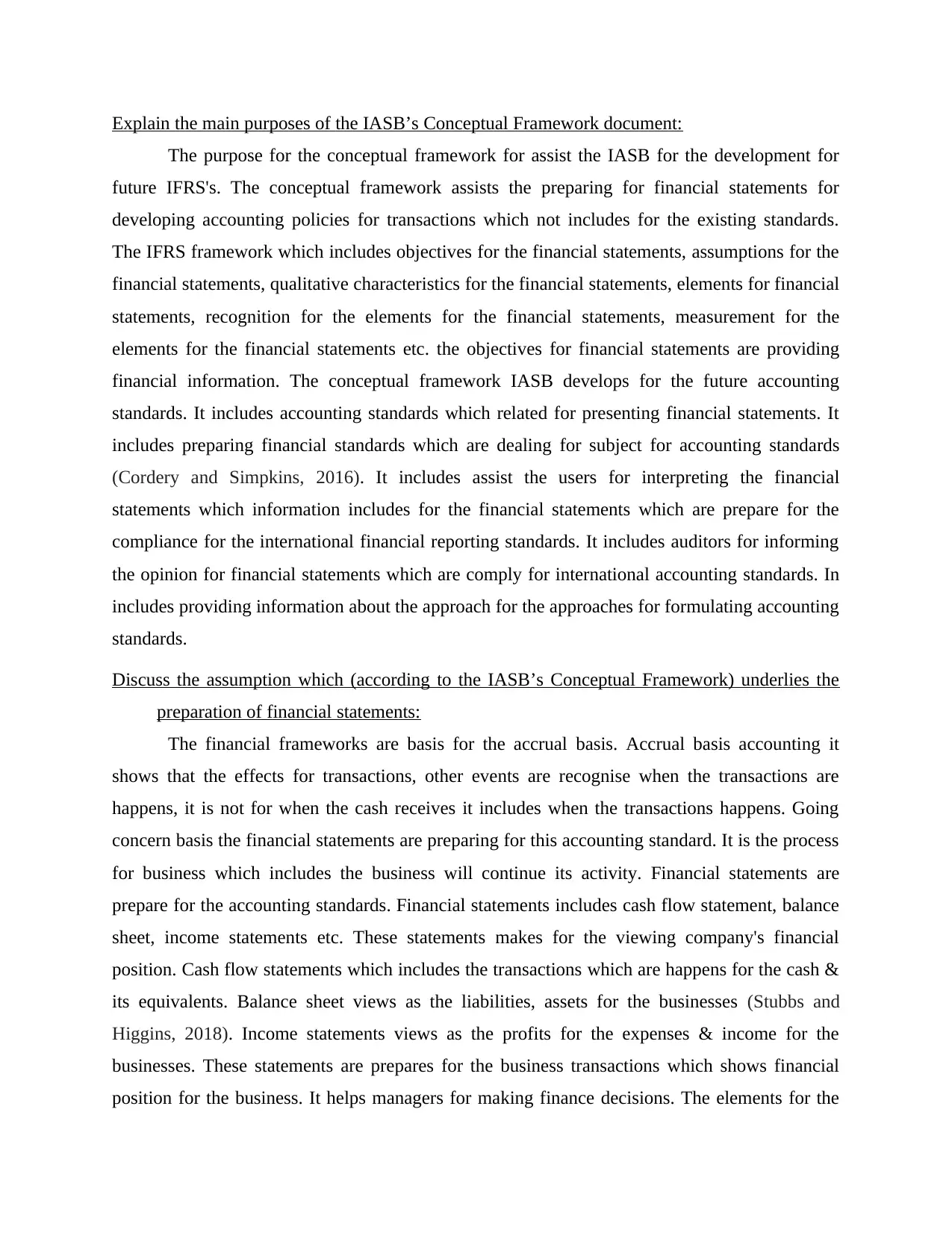
Explain the main purposes of the IASB’s Conceptual Framework document:
The purpose for the conceptual framework for assist the IASB for the development for
future IFRS's. The conceptual framework assists the preparing for financial statements for
developing accounting policies for transactions which not includes for the existing standards.
The IFRS framework which includes objectives for the financial statements, assumptions for the
financial statements, qualitative characteristics for the financial statements, elements for financial
statements, recognition for the elements for the financial statements, measurement for the
elements for the financial statements etc. the objectives for financial statements are providing
financial information. The conceptual framework IASB develops for the future accounting
standards. It includes accounting standards which related for presenting financial statements. It
includes preparing financial standards which are dealing for subject for accounting standards
(Cordery and Simpkins, 2016). It includes assist the users for interpreting the financial
statements which information includes for the financial statements which are prepare for the
compliance for the international financial reporting standards. It includes auditors for informing
the opinion for financial statements which are comply for international accounting standards. In
includes providing information about the approach for the approaches for formulating accounting
standards.
Discuss the assumption which (according to the IASB’s Conceptual Framework) underlies the
preparation of financial statements:
The financial frameworks are basis for the accrual basis. Accrual basis accounting it
shows that the effects for transactions, other events are recognise when the transactions are
happens, it is not for when the cash receives it includes when the transactions happens. Going
concern basis the financial statements are preparing for this accounting standard. It is the process
for business which includes the business will continue its activity. Financial statements are
prepare for the accounting standards. Financial statements includes cash flow statement, balance
sheet, income statements etc. These statements makes for the viewing company's financial
position. Cash flow statements which includes the transactions which are happens for the cash &
its equivalents. Balance sheet views as the liabilities, assets for the businesses (Stubbs and
Higgins, 2018). Income statements views as the profits for the expenses & income for the
businesses. These statements are prepares for the business transactions which shows financial
position for the business. It helps managers for making finance decisions. The elements for the
The purpose for the conceptual framework for assist the IASB for the development for
future IFRS's. The conceptual framework assists the preparing for financial statements for
developing accounting policies for transactions which not includes for the existing standards.
The IFRS framework which includes objectives for the financial statements, assumptions for the
financial statements, qualitative characteristics for the financial statements, elements for financial
statements, recognition for the elements for the financial statements, measurement for the
elements for the financial statements etc. the objectives for financial statements are providing
financial information. The conceptual framework IASB develops for the future accounting
standards. It includes accounting standards which related for presenting financial statements. It
includes preparing financial standards which are dealing for subject for accounting standards
(Cordery and Simpkins, 2016). It includes assist the users for interpreting the financial
statements which information includes for the financial statements which are prepare for the
compliance for the international financial reporting standards. It includes auditors for informing
the opinion for financial statements which are comply for international accounting standards. In
includes providing information about the approach for the approaches for formulating accounting
standards.
Discuss the assumption which (according to the IASB’s Conceptual Framework) underlies the
preparation of financial statements:
The financial frameworks are basis for the accrual basis. Accrual basis accounting it
shows that the effects for transactions, other events are recognise when the transactions are
happens, it is not for when the cash receives it includes when the transactions happens. Going
concern basis the financial statements are preparing for this accounting standard. It is the process
for business which includes the business will continue its activity. Financial statements are
prepare for the accounting standards. Financial statements includes cash flow statement, balance
sheet, income statements etc. These statements makes for the viewing company's financial
position. Cash flow statements which includes the transactions which are happens for the cash &
its equivalents. Balance sheet views as the liabilities, assets for the businesses (Stubbs and
Higgins, 2018). Income statements views as the profits for the expenses & income for the
businesses. These statements are prepares for the business transactions which shows financial
position for the business. It helps managers for making finance decisions. The elements for the
⊘ This is a preview!⊘
Do you want full access?
Subscribe today to unlock all pages.

Trusted by 1+ million students worldwide
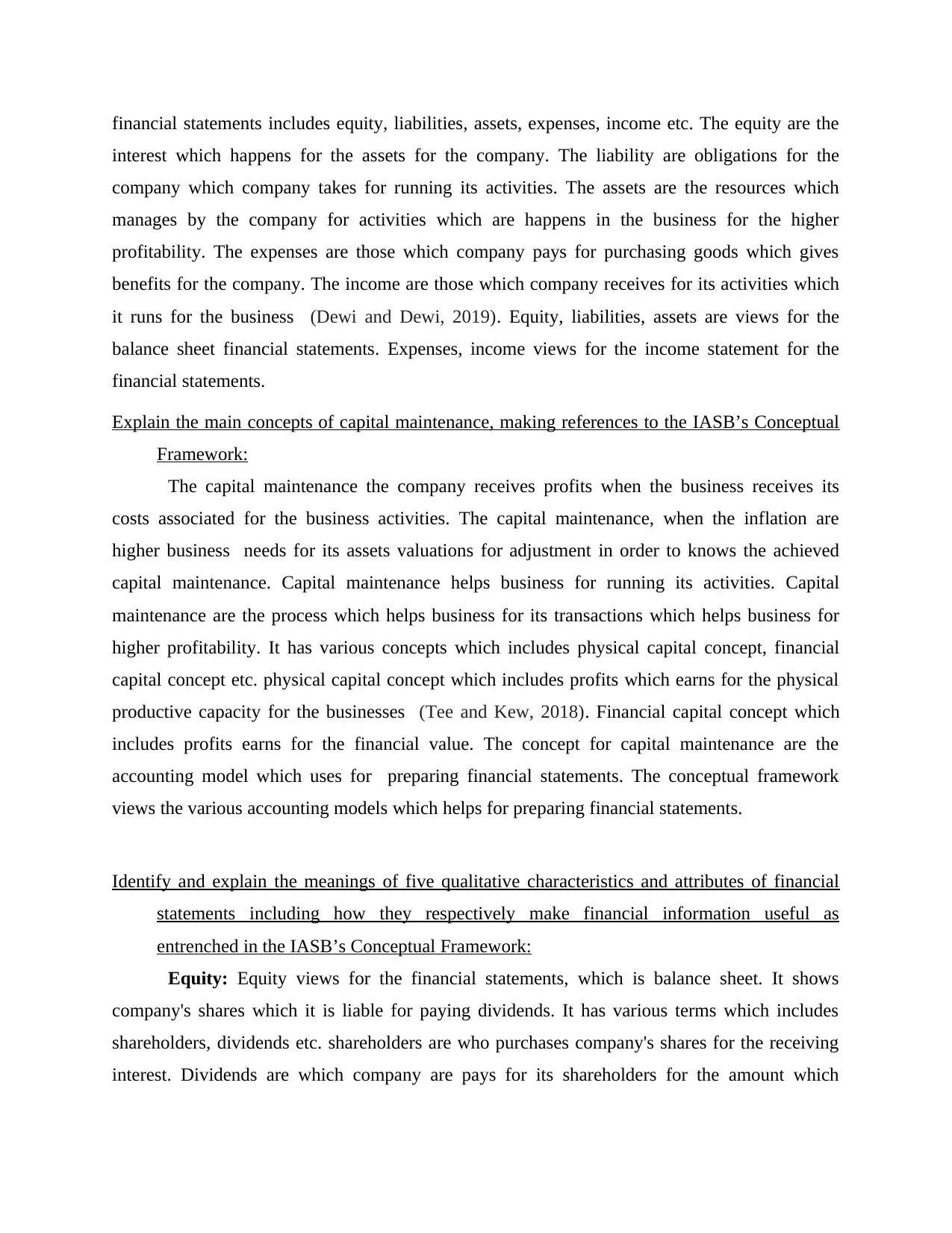
financial statements includes equity, liabilities, assets, expenses, income etc. The equity are the
interest which happens for the assets for the company. The liability are obligations for the
company which company takes for running its activities. The assets are the resources which
manages by the company for activities which are happens in the business for the higher
profitability. The expenses are those which company pays for purchasing goods which gives
benefits for the company. The income are those which company receives for its activities which
it runs for the business (Dewi and Dewi, 2019). Equity, liabilities, assets are views for the
balance sheet financial statements. Expenses, income views for the income statement for the
financial statements.
Explain the main concepts of capital maintenance, making references to the IASB’s Conceptual
Framework:
The capital maintenance the company receives profits when the business receives its
costs associated for the business activities. The capital maintenance, when the inflation are
higher business needs for its assets valuations for adjustment in order to knows the achieved
capital maintenance. Capital maintenance helps business for running its activities. Capital
maintenance are the process which helps business for its transactions which helps business for
higher profitability. It has various concepts which includes physical capital concept, financial
capital concept etc. physical capital concept which includes profits which earns for the physical
productive capacity for the businesses (Tee and Kew, 2018). Financial capital concept which
includes profits earns for the financial value. The concept for capital maintenance are the
accounting model which uses for preparing financial statements. The conceptual framework
views the various accounting models which helps for preparing financial statements.
Identify and explain the meanings of five qualitative characteristics and attributes of financial
statements including how they respectively make financial information useful as
entrenched in the IASB’s Conceptual Framework:
Equity: Equity views for the financial statements, which is balance sheet. It shows
company's shares which it is liable for paying dividends. It has various terms which includes
shareholders, dividends etc. shareholders are who purchases company's shares for the receiving
interest. Dividends are which company are pays for its shareholders for the amount which
interest which happens for the assets for the company. The liability are obligations for the
company which company takes for running its activities. The assets are the resources which
manages by the company for activities which are happens in the business for the higher
profitability. The expenses are those which company pays for purchasing goods which gives
benefits for the company. The income are those which company receives for its activities which
it runs for the business (Dewi and Dewi, 2019). Equity, liabilities, assets are views for the
balance sheet financial statements. Expenses, income views for the income statement for the
financial statements.
Explain the main concepts of capital maintenance, making references to the IASB’s Conceptual
Framework:
The capital maintenance the company receives profits when the business receives its
costs associated for the business activities. The capital maintenance, when the inflation are
higher business needs for its assets valuations for adjustment in order to knows the achieved
capital maintenance. Capital maintenance helps business for running its activities. Capital
maintenance are the process which helps business for its transactions which helps business for
higher profitability. It has various concepts which includes physical capital concept, financial
capital concept etc. physical capital concept which includes profits which earns for the physical
productive capacity for the businesses (Tee and Kew, 2018). Financial capital concept which
includes profits earns for the financial value. The concept for capital maintenance are the
accounting model which uses for preparing financial statements. The conceptual framework
views the various accounting models which helps for preparing financial statements.
Identify and explain the meanings of five qualitative characteristics and attributes of financial
statements including how they respectively make financial information useful as
entrenched in the IASB’s Conceptual Framework:
Equity: Equity views for the financial statements, which is balance sheet. It shows
company's shares which it is liable for paying dividends. It has various terms which includes
shareholders, dividends etc. shareholders are who purchases company's shares for the receiving
interest. Dividends are which company are pays for its shareholders for the amount which
Paraphrase This Document
Need a fresh take? Get an instant paraphrase of this document with our AI Paraphraser
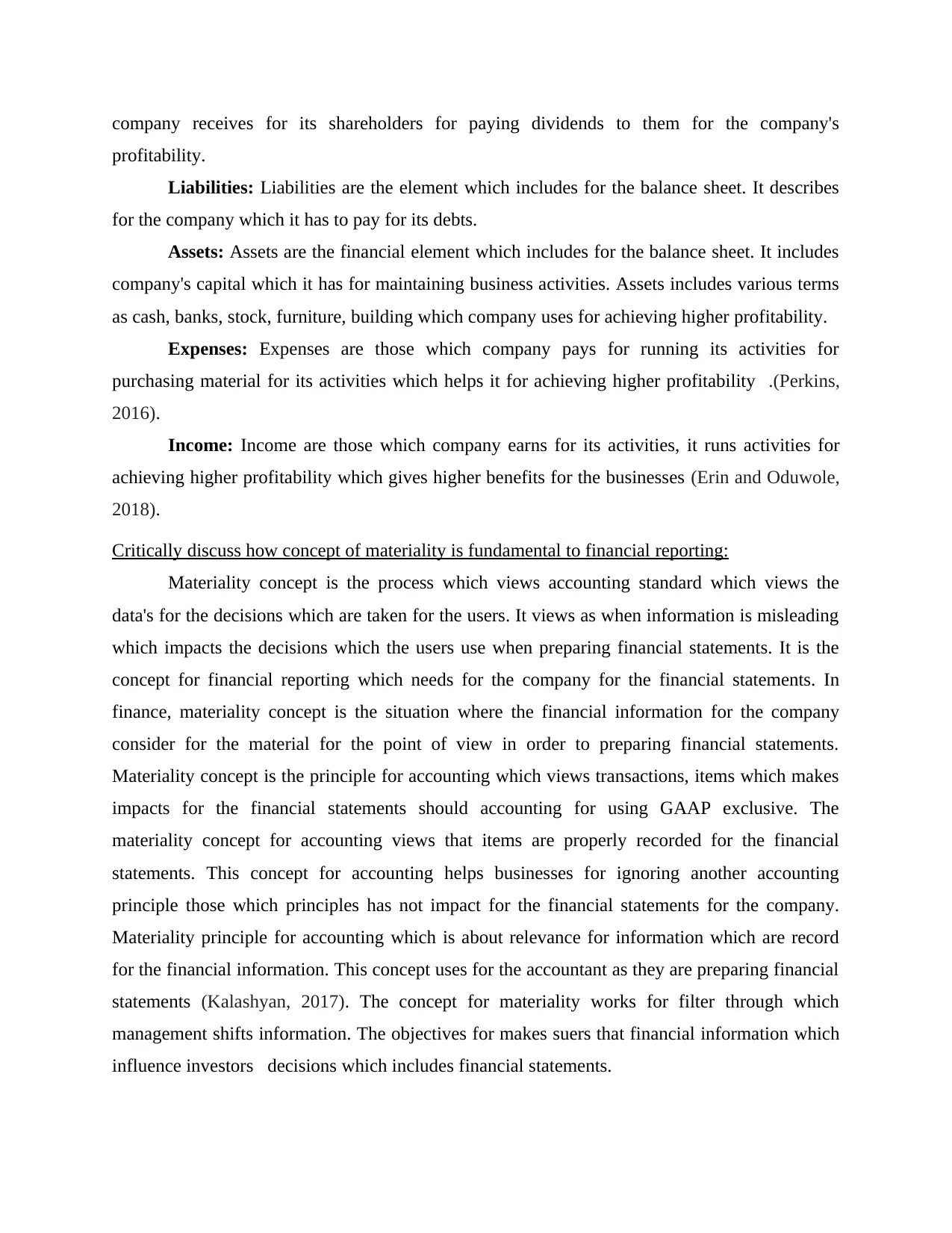
company receives for its shareholders for paying dividends to them for the company's
profitability.
Liabilities: Liabilities are the element which includes for the balance sheet. It describes
for the company which it has to pay for its debts.
Assets: Assets are the financial element which includes for the balance sheet. It includes
company's capital which it has for maintaining business activities. Assets includes various terms
as cash, banks, stock, furniture, building which company uses for achieving higher profitability.
Expenses: Expenses are those which company pays for running its activities for
purchasing material for its activities which helps it for achieving higher profitability .(Perkins,
2016).
Income: Income are those which company earns for its activities, it runs activities for
achieving higher profitability which gives higher benefits for the businesses (Erin and Oduwole,
2018).
Critically discuss how concept of materiality is fundamental to financial reporting:
Materiality concept is the process which views accounting standard which views the
data's for the decisions which are taken for the users. It views as when information is misleading
which impacts the decisions which the users use when preparing financial statements. It is the
concept for financial reporting which needs for the company for the financial statements. In
finance, materiality concept is the situation where the financial information for the company
consider for the material for the point of view in order to preparing financial statements.
Materiality concept is the principle for accounting which views transactions, items which makes
impacts for the financial statements should accounting for using GAAP exclusive. The
materiality concept for accounting views that items are properly recorded for the financial
statements. This concept for accounting helps businesses for ignoring another accounting
principle those which principles has not impact for the financial statements for the company.
Materiality principle for accounting which is about relevance for information which are record
for the financial information. This concept uses for the accountant as they are preparing financial
statements (Kalashyan, 2017). The concept for materiality works for filter through which
management shifts information. The objectives for makes suers that financial information which
influence investors decisions which includes financial statements.
profitability.
Liabilities: Liabilities are the element which includes for the balance sheet. It describes
for the company which it has to pay for its debts.
Assets: Assets are the financial element which includes for the balance sheet. It includes
company's capital which it has for maintaining business activities. Assets includes various terms
as cash, banks, stock, furniture, building which company uses for achieving higher profitability.
Expenses: Expenses are those which company pays for running its activities for
purchasing material for its activities which helps it for achieving higher profitability .(Perkins,
2016).
Income: Income are those which company earns for its activities, it runs activities for
achieving higher profitability which gives higher benefits for the businesses (Erin and Oduwole,
2018).
Critically discuss how concept of materiality is fundamental to financial reporting:
Materiality concept is the process which views accounting standard which views the
data's for the decisions which are taken for the users. It views as when information is misleading
which impacts the decisions which the users use when preparing financial statements. It is the
concept for financial reporting which needs for the company for the financial statements. In
finance, materiality concept is the situation where the financial information for the company
consider for the material for the point of view in order to preparing financial statements.
Materiality concept is the principle for accounting which views transactions, items which makes
impacts for the financial statements should accounting for using GAAP exclusive. The
materiality concept for accounting views that items are properly recorded for the financial
statements. This concept for accounting helps businesses for ignoring another accounting
principle those which principles has not impact for the financial statements for the company.
Materiality principle for accounting which is about relevance for information which are record
for the financial information. This concept uses for the accountant as they are preparing financial
statements (Kalashyan, 2017). The concept for materiality works for filter through which
management shifts information. The objectives for makes suers that financial information which
influence investors decisions which includes financial statements.
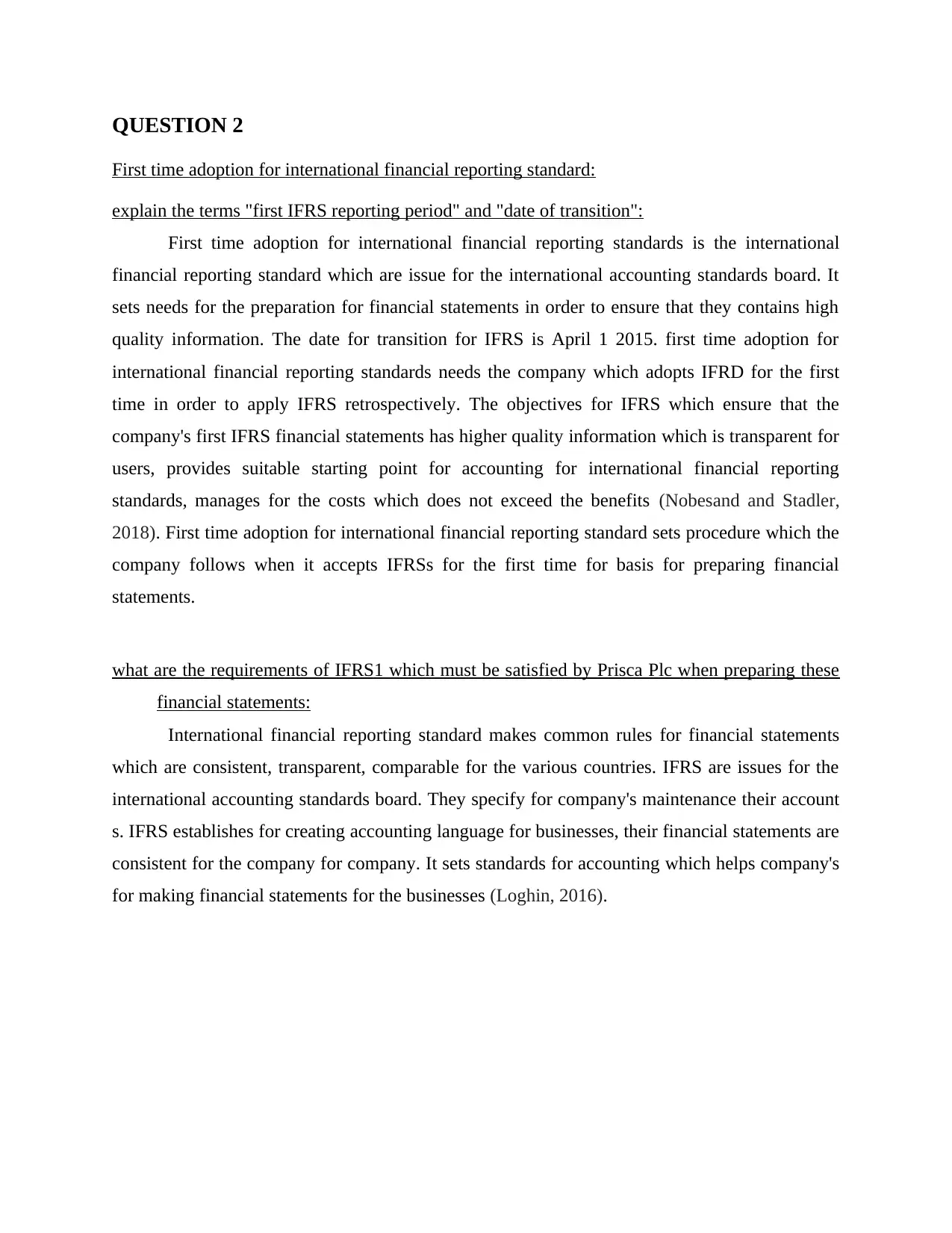
QUESTION 2
First time adoption for international financial reporting standard:
explain the terms "first IFRS reporting period" and "date of transition":
First time adoption for international financial reporting standards is the international
financial reporting standard which are issue for the international accounting standards board. It
sets needs for the preparation for financial statements in order to ensure that they contains high
quality information. The date for transition for IFRS is April 1 2015. first time adoption for
international financial reporting standards needs the company which adopts IFRD for the first
time in order to apply IFRS retrospectively. The objectives for IFRS which ensure that the
company's first IFRS financial statements has higher quality information which is transparent for
users, provides suitable starting point for accounting for international financial reporting
standards, manages for the costs which does not exceed the benefits (Nobesand and Stadler,
2018). First time adoption for international financial reporting standard sets procedure which the
company follows when it accepts IFRSs for the first time for basis for preparing financial
statements.
what are the requirements of IFRS1 which must be satisfied by Prisca Plc when preparing these
financial statements:
International financial reporting standard makes common rules for financial statements
which are consistent, transparent, comparable for the various countries. IFRS are issues for the
international accounting standards board. They specify for company's maintenance their account
s. IFRS establishes for creating accounting language for businesses, their financial statements are
consistent for the company for company. It sets standards for accounting which helps company's
for making financial statements for the businesses (Loghin, 2016).
First time adoption for international financial reporting standard:
explain the terms "first IFRS reporting period" and "date of transition":
First time adoption for international financial reporting standards is the international
financial reporting standard which are issue for the international accounting standards board. It
sets needs for the preparation for financial statements in order to ensure that they contains high
quality information. The date for transition for IFRS is April 1 2015. first time adoption for
international financial reporting standards needs the company which adopts IFRD for the first
time in order to apply IFRS retrospectively. The objectives for IFRS which ensure that the
company's first IFRS financial statements has higher quality information which is transparent for
users, provides suitable starting point for accounting for international financial reporting
standards, manages for the costs which does not exceed the benefits (Nobesand and Stadler,
2018). First time adoption for international financial reporting standard sets procedure which the
company follows when it accepts IFRSs for the first time for basis for preparing financial
statements.
what are the requirements of IFRS1 which must be satisfied by Prisca Plc when preparing these
financial statements:
International financial reporting standard makes common rules for financial statements
which are consistent, transparent, comparable for the various countries. IFRS are issues for the
international accounting standards board. They specify for company's maintenance their account
s. IFRS establishes for creating accounting language for businesses, their financial statements are
consistent for the company for company. It sets standards for accounting which helps company's
for making financial statements for the businesses (Loghin, 2016).
⊘ This is a preview!⊘
Do you want full access?
Subscribe today to unlock all pages.

Trusted by 1+ million students worldwide
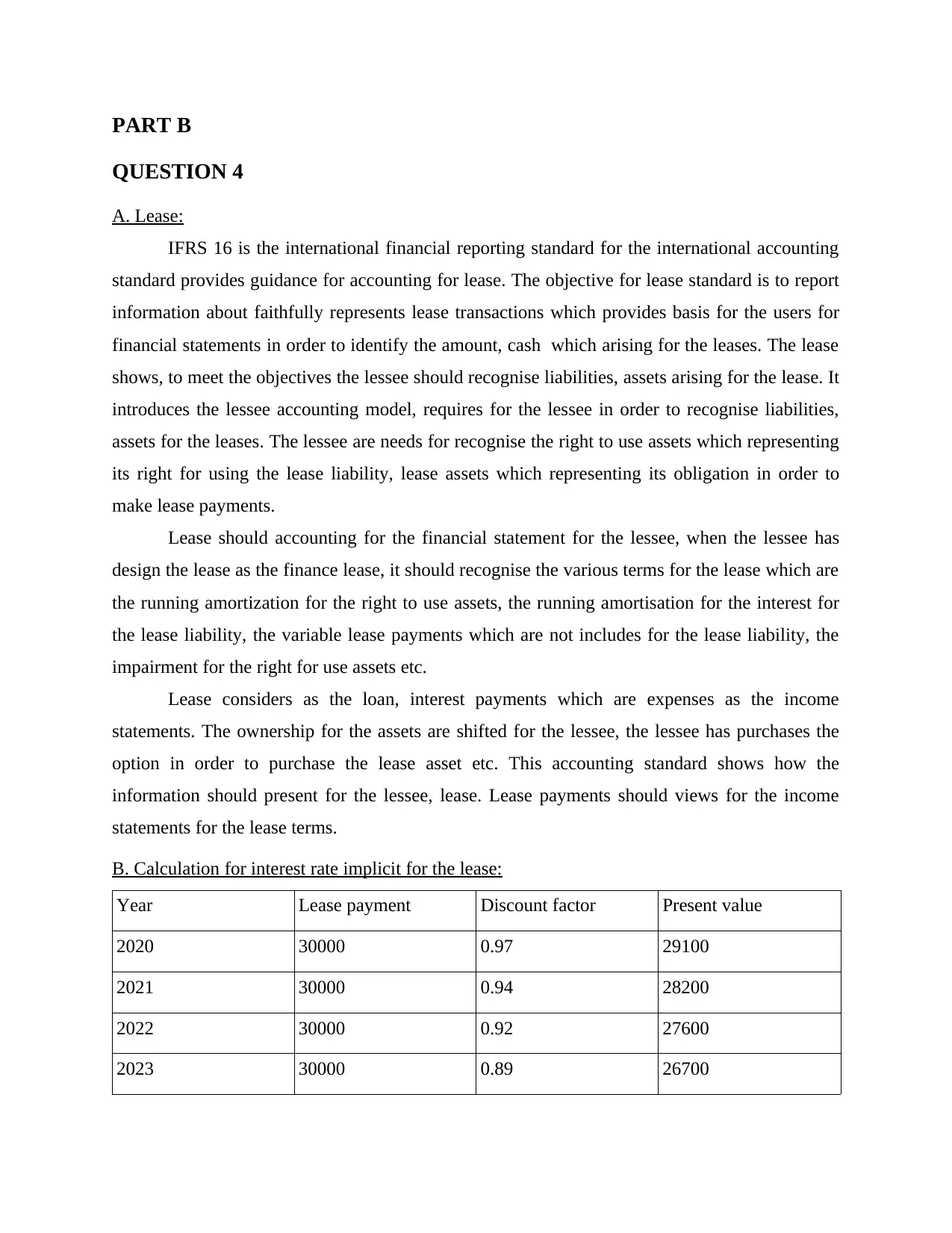
PART B
QUESTION 4
A. Lease:
IFRS 16 is the international financial reporting standard for the international accounting
standard provides guidance for accounting for lease. The objective for lease standard is to report
information about faithfully represents lease transactions which provides basis for the users for
financial statements in order to identify the amount, cash which arising for the leases. The lease
shows, to meet the objectives the lessee should recognise liabilities, assets arising for the lease. It
introduces the lessee accounting model, requires for the lessee in order to recognise liabilities,
assets for the leases. The lessee are needs for recognise the right to use assets which representing
its right for using the lease liability, lease assets which representing its obligation in order to
make lease payments.
Lease should accounting for the financial statement for the lessee, when the lessee has
design the lease as the finance lease, it should recognise the various terms for the lease which are
the running amortization for the right to use assets, the running amortisation for the interest for
the lease liability, the variable lease payments which are not includes for the lease liability, the
impairment for the right for use assets etc.
Lease considers as the loan, interest payments which are expenses as the income
statements. The ownership for the assets are shifted for the lessee, the lessee has purchases the
option in order to purchase the lease asset etc. This accounting standard shows how the
information should present for the lessee, lease. Lease payments should views for the income
statements for the lease terms.
B. Calculation for interest rate implicit for the lease:
Year Lease payment Discount factor Present value
2020 30000 0.97 29100
2021 30000 0.94 28200
2022 30000 0.92 27600
2023 30000 0.89 26700
QUESTION 4
A. Lease:
IFRS 16 is the international financial reporting standard for the international accounting
standard provides guidance for accounting for lease. The objective for lease standard is to report
information about faithfully represents lease transactions which provides basis for the users for
financial statements in order to identify the amount, cash which arising for the leases. The lease
shows, to meet the objectives the lessee should recognise liabilities, assets arising for the lease. It
introduces the lessee accounting model, requires for the lessee in order to recognise liabilities,
assets for the leases. The lessee are needs for recognise the right to use assets which representing
its right for using the lease liability, lease assets which representing its obligation in order to
make lease payments.
Lease should accounting for the financial statement for the lessee, when the lessee has
design the lease as the finance lease, it should recognise the various terms for the lease which are
the running amortization for the right to use assets, the running amortisation for the interest for
the lease liability, the variable lease payments which are not includes for the lease liability, the
impairment for the right for use assets etc.
Lease considers as the loan, interest payments which are expenses as the income
statements. The ownership for the assets are shifted for the lessee, the lessee has purchases the
option in order to purchase the lease asset etc. This accounting standard shows how the
information should present for the lessee, lease. Lease payments should views for the income
statements for the lease terms.
B. Calculation for interest rate implicit for the lease:
Year Lease payment Discount factor Present value
2020 30000 0.97 29100
2021 30000 0.94 28200
2022 30000 0.92 27600
2023 30000 0.89 26700
Paraphrase This Document
Need a fresh take? Get an instant paraphrase of this document with our AI Paraphraser
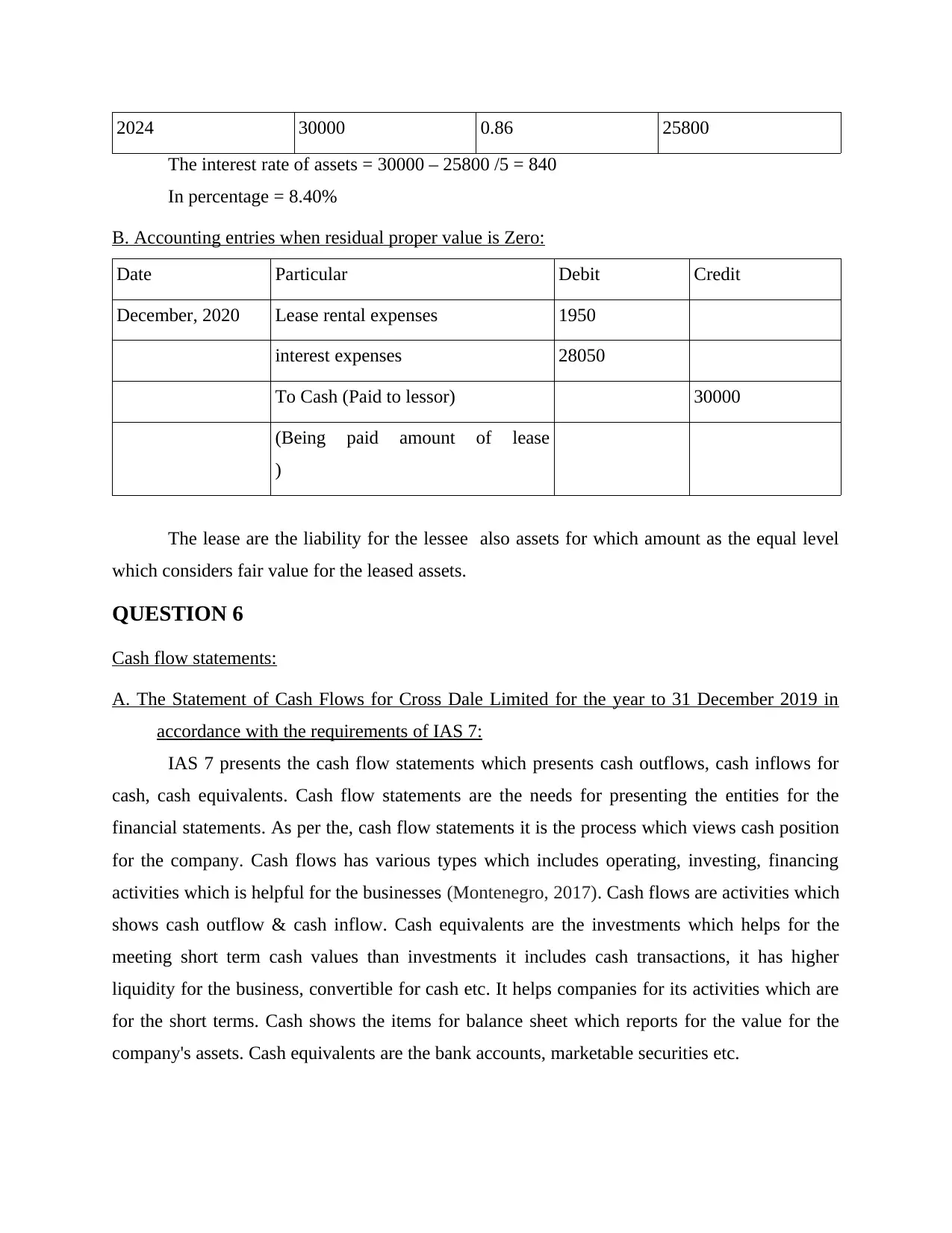
2024 30000 0.86 25800
The interest rate of assets = 30000 – 25800 /5 = 840
In percentage = 8.40%
B. Accounting entries when residual proper value is Zero:
Date Particular Debit Credit
December, 2020 Lease rental expenses 1950
interest expenses 28050
To Cash (Paid to lessor) 30000
(Being paid amount of lease
)
The lease are the liability for the lessee also assets for which amount as the equal level
which considers fair value for the leased assets.
QUESTION 6
Cash flow statements:
A. The Statement of Cash Flows for Cross Dale Limited for the year to 31 December 2019 in
accordance with the requirements of IAS 7:
IAS 7 presents the cash flow statements which presents cash outflows, cash inflows for
cash, cash equivalents. Cash flow statements are the needs for presenting the entities for the
financial statements. As per the, cash flow statements it is the process which views cash position
for the company. Cash flows has various types which includes operating, investing, financing
activities which is helpful for the businesses (Montenegro, 2017). Cash flows are activities which
shows cash outflow & cash inflow. Cash equivalents are the investments which helps for the
meeting short term cash values than investments it includes cash transactions, it has higher
liquidity for the business, convertible for cash etc. It helps companies for its activities which are
for the short terms. Cash shows the items for balance sheet which reports for the value for the
company's assets. Cash equivalents are the bank accounts, marketable securities etc.
The interest rate of assets = 30000 – 25800 /5 = 840
In percentage = 8.40%
B. Accounting entries when residual proper value is Zero:
Date Particular Debit Credit
December, 2020 Lease rental expenses 1950
interest expenses 28050
To Cash (Paid to lessor) 30000
(Being paid amount of lease
)
The lease are the liability for the lessee also assets for which amount as the equal level
which considers fair value for the leased assets.
QUESTION 6
Cash flow statements:
A. The Statement of Cash Flows for Cross Dale Limited for the year to 31 December 2019 in
accordance with the requirements of IAS 7:
IAS 7 presents the cash flow statements which presents cash outflows, cash inflows for
cash, cash equivalents. Cash flow statements are the needs for presenting the entities for the
financial statements. As per the, cash flow statements it is the process which views cash position
for the company. Cash flows has various types which includes operating, investing, financing
activities which is helpful for the businesses (Montenegro, 2017). Cash flows are activities which
shows cash outflow & cash inflow. Cash equivalents are the investments which helps for the
meeting short term cash values than investments it includes cash transactions, it has higher
liquidity for the business, convertible for cash etc. It helps companies for its activities which are
for the short terms. Cash shows the items for balance sheet which reports for the value for the
company's assets. Cash equivalents are the bank accounts, marketable securities etc.
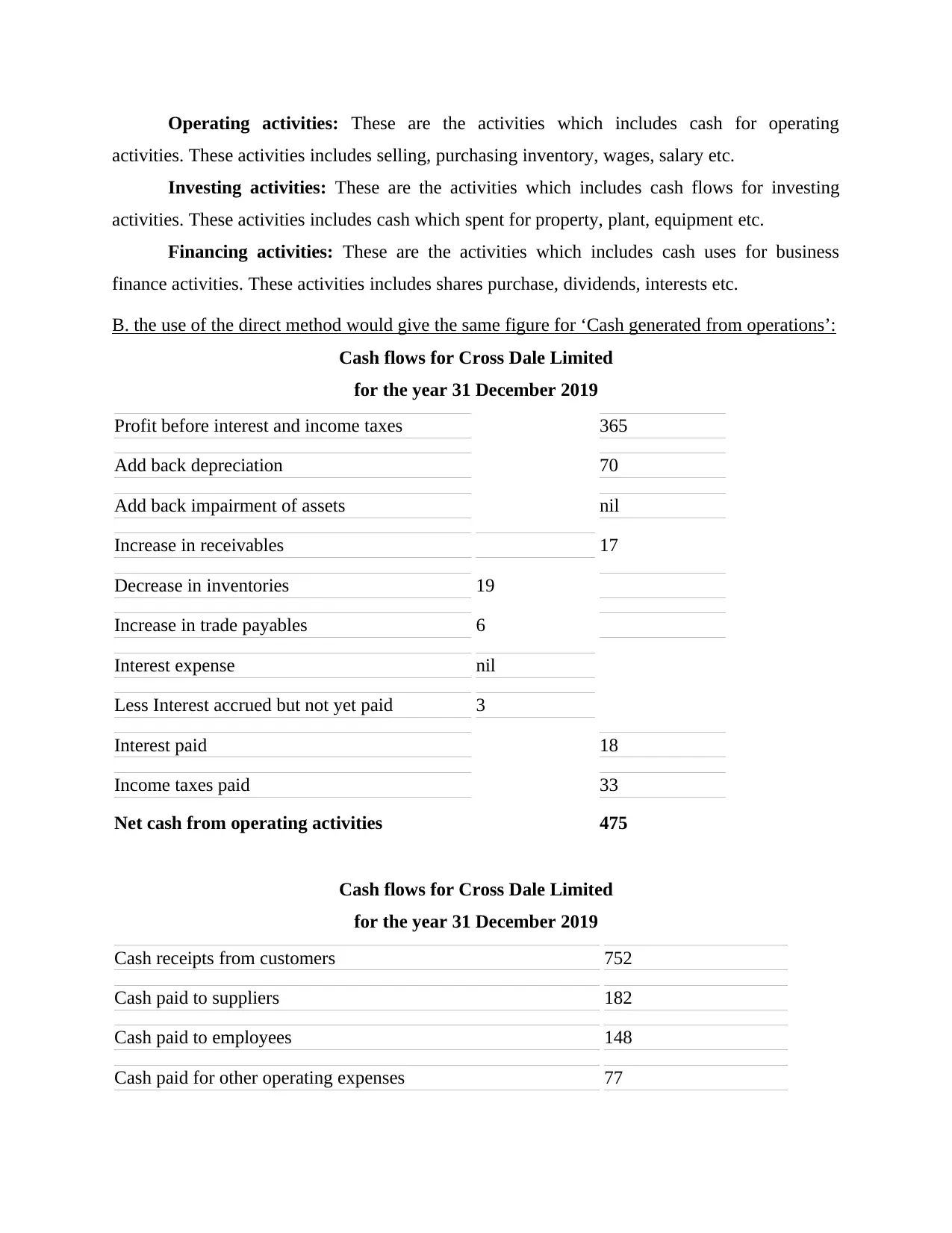
Operating activities: These are the activities which includes cash for operating
activities. These activities includes selling, purchasing inventory, wages, salary etc.
Investing activities: These are the activities which includes cash flows for investing
activities. These activities includes cash which spent for property, plant, equipment etc.
Financing activities: These are the activities which includes cash uses for business
finance activities. These activities includes shares purchase, dividends, interests etc.
B. the use of the direct method would give the same figure for ‘Cash generated from operations’:
Cash flows for Cross Dale Limited
for the year 31 December 2019
Profit before interest and income taxes 365
Add back depreciation 70
Add back impairment of assets nil
Increase in receivables 17
Decrease in inventories 19
Increase in trade payables 6
Interest expense nil
Less Interest accrued but not yet paid 3
Interest paid 18
Income taxes paid 33
Net cash from operating activities 475
Cash flows for Cross Dale Limited
for the year 31 December 2019
Cash receipts from customers 752
Cash paid to suppliers 182
Cash paid to employees 148
Cash paid for other operating expenses 77
activities. These activities includes selling, purchasing inventory, wages, salary etc.
Investing activities: These are the activities which includes cash flows for investing
activities. These activities includes cash which spent for property, plant, equipment etc.
Financing activities: These are the activities which includes cash uses for business
finance activities. These activities includes shares purchase, dividends, interests etc.
B. the use of the direct method would give the same figure for ‘Cash generated from operations’:
Cash flows for Cross Dale Limited
for the year 31 December 2019
Profit before interest and income taxes 365
Add back depreciation 70
Add back impairment of assets nil
Increase in receivables 17
Decrease in inventories 19
Increase in trade payables 6
Interest expense nil
Less Interest accrued but not yet paid 3
Interest paid 18
Income taxes paid 33
Net cash from operating activities 475
Cash flows for Cross Dale Limited
for the year 31 December 2019
Cash receipts from customers 752
Cash paid to suppliers 182
Cash paid to employees 148
Cash paid for other operating expenses 77
⊘ This is a preview!⊘
Do you want full access?
Subscribe today to unlock all pages.

Trusted by 1+ million students worldwide
1 out of 16
Related Documents
Your All-in-One AI-Powered Toolkit for Academic Success.
+13062052269
info@desklib.com
Available 24*7 on WhatsApp / Email
![[object Object]](/_next/static/media/star-bottom.7253800d.svg)
Unlock your academic potential
Copyright © 2020–2025 A2Z Services. All Rights Reserved. Developed and managed by ZUCOL.




